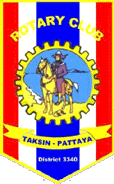- HEADLINES [click on headline to view story]:
-
Traditional values featured in Pattaya’s April 13 Songkran parade and festival
-
Château visit in Bordeaux
-
Indian delegation visits Pattaya to savor the sights of fun city
-
Sheraton Grande Sunday Menu: Buffet Lunch and Jazz A La Carte
|
|
Traditional values featured in Pattaya’s April 13 Songkran parade and festival
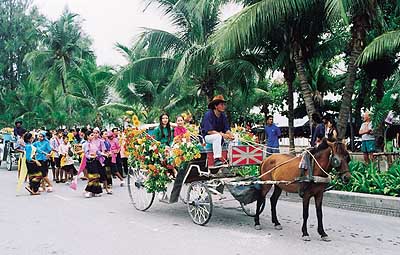
Horse
drawn floral floats, Thai costumes, dancing and decorations from all 4
regions of Thailand highlighted the parade.
April 13 was the official national Songkran holiday in
Thailand and throughout the Southeast Asian region. It has long been
considered the unofficial Thai New Year (it was for a time the official
Thai New Year), and Family Day. And although everywhere else the
celebrations end on April 15, in Pattaya they last throughout the week,
culminating in total water throwing madness on April 19.
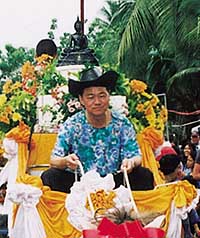 Mayor
Pairat Suthithamrongsawat arrived at the festivities by horse drawn
carriage. Mayor
Pairat Suthithamrongsawat arrived at the festivities by horse drawn
carriage.
This year, the City of Pattaya joined the rest of the
Kingdom in trying to calm things down whilst attempting to bring back
traditional Thai values during the celebrations. Talcum powder, ice water
and high-powered water guns, including modified PVC pumps, were officially
banned, and police warned that violations could result in up to 2000 baht
fines. People were, are still are, being asked to respect the rights of
others, many of whom, despite the holiday, must still try to make a living
and get to work.
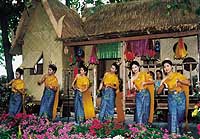 Pattaya’s
Songkran Festival featured stage performances, games and plays. Pattaya’s
Songkran Festival featured stage performances, games and plays.
The intended spirit of the ancient festival is one of
gentleness and thankfulness, paying respect to elders and showing
appreciation for the gift of life-giving water.
To help promote these traditional values, the city
organized a parade and festival on the extended Walking Street along Beach
Road from Central to South Pattaya.
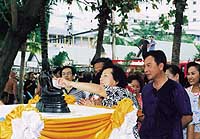 Devout
Buddhist poured water over statues of Buddha. Devout
Buddhist poured water over statues of Buddha.
The festivities began early in the day. Starting at 6
a.m., alms were given to 90 monks, who then blessed the faithful by
sprinkling holy water onto them using a their sacred wisp.
Later in the day, beginning at 3 p.m., a parade was
held, featuring horse drawn carriages, long drums, traditional Thai
costumes and decorations from all four parts of Thailand.
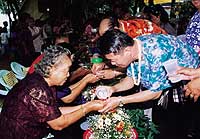 After
the parade, Mayor Pairat and friends paid respect to their elders in the
traditional way. After
the parade, Mayor Pairat and friends paid respect to their elders in the
traditional way.
Following the parade, people paid respect to the
town’s elderly, gently pouring small amounts of water over their hands
from silver cups. Many also observed the tradition of pouring water over
Buddha statues.
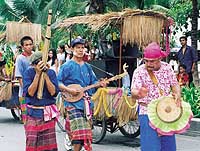 Indigenous
Thai instruments were featured during the parade. Indigenous
Thai instruments were featured during the parade.
The theme behind this year’s much smaller version of
Pattaya’s Songkran Festival was to show Thai and foreign tourists how to
uphold the traditional ways of celebrating Songkran. Traditional games
were played, ancient stage plays were performed, and beautiful maidens in
traditional costumes performed Thai dances.
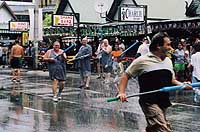 There
was still the small army of beer-filled farangs and service girls who
chose to ignore traditional Thai values and soak everyone in sight.
However, this year by doing so they just might contribute to the filling
of police coffers, as there has been a 2000 baht fine announced for using
PVC pipes (like the ones shown here), ice water and talcum powder. There
was still the small army of beer-filled farangs and service girls who
chose to ignore traditional Thai values and soak everyone in sight.
However, this year by doing so they just might contribute to the filling
of police coffers, as there has been a 2000 baht fine announced for using
PVC pipes (like the ones shown here), ice water and talcum powder.
Château visit in Bordeaux
By Ranjith Chandrasiri
Bordeaux region has over 9,000 wineries, sixty
cooperative cellars and four hundred wine shippers according to the
statistics available from the official trade organization - the CIVB (Conseil
Interprofessionnel du Vin de Bordeaux). There are more than 13,000 growers
harvesting grapes each year, and about 5,000 châteaux bottle their own
wines. However, it’s the top 100 or so superstar châteaux of the region
that attract the world’s attention.
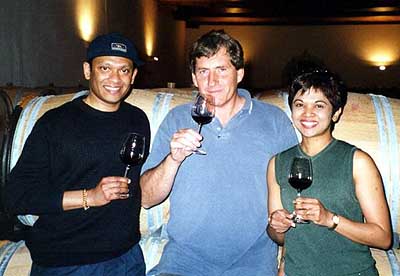
Ranjith
and Chitra Chandrasiri with Bruno Sainson barrel tasting the Chโteau
Laroque Grand Cru vintage 2000 in the main cellar.
At the very top end of the market are the heavyweights
such as Margaux, Latour, Mouton-Rothschild, Lafite Rothschild, Haut-Brion,
P้trus, Cheval-Blanc and Ausone with the greatest demand and
highest-priced wines. In recent years, a number of small-producers from
St.-Emilion and Pomerol have challenged the market leadership, and they
have become highly sought after by Bordeaux wine collectors. Their wines
are often sold for higher prices than the traditional leaders. Among these
newcomers are Château Le Pin, L’Église Clinet, La Mondotte and
Valandraud. Each year a surprising number of small new producers, often
called “vins de garage” (garage wines) since their production is so
small and the wines are made in small wineries in the size of a
“garage”, suddenly become superstars in the world of wine. Collectors
and speculators are invariably on the lookout for top quality, limited
productions, especially from St.-Emilion and Pomerol for their future
potential. It’s a star search for the next Château P้trus, Le Pin
or Valandraud.
This doesn’t mean that the most expensive wines are
always the best. Particularly in a top vintage, “lesser” producers may
make equally outstanding wines. For instance, one of the top wines made in
the legendary vintage of 1990 was Sociando-Mallet, a low-ranked château
(with an official rating of cru bourgeois) that consistently makes some of
the best wines of the region.
Château Laroque, a Grand Cru Class้ of St.-Emilion
is one of my picks for an outstanding wine that is still affordable
compared to some of the astonishingly priced wines in the appellation.
Among many other factors, uncompromising quality control, dedication and
the skills of the wine maker are the most important human factors for
making high quality wines. In 1982, when Bruno Sainson became the estate
manager of Château Laroque, he launched a quality policy that has been
rigorously and enthusiastically maintained in the past two decades under
his leadership. Vineyard management was carefully integrated with a
large-scale investment project as part of a long-term development plan.
The best vineyard plots were carefully replanted while the winemaking and
ageing methods were upgraded. Years of hard work and dedication finally
paid off when Château Laroque was awarded the Grand Cru Class้
status in the 1996 St.-Emilion classification review. This award means
recognition for Chโteau Laroque, but is not the “be all and end
all”; its pursuit of quality remains unwavering, justifying its position
among the leading wines of the appellation.
Properties in St.-Emilion and Pemerol are generally
small, family run affairs with an absence of a grandiose chโteau.
You will be quite surprised to see even the great Château P้trus is
actually no more than a couple of buildings in which the wines are made
and matured with no grand château in sight. In this aspect, Château
Laroque is unique compared to its famous superstar neighbours. It boasts a
magnificent chโteau, a glorious example of Louis XIV architecture
with finely crafted wrought iron work, wide straight garden walks
decorated with statues and balusters in the foreground of the grand
building with pale stone fa็ade and large ornate windows. Its
elegant white silhouette stands gracefully overlooking the Dordogne River
Valley, rising above the tiny rolling hills embedded in a lush green quilt
of vineyards. Restoration of the old château is on the cards in the long
term development plan, but for Bruno, the most important priority for now
is perfecting his wine.
The estate dates back to the distant era of
Anglo-Norman invasion. All that remains of that feudal past is an imposing
tower that had been left standing when the château was built in the
seventeenth century. The vineyard had also been planted around that time
and had been under the ownership of the Marquis de Rochefort-Lavie family.
Revival of the estate began in 1935, when the Beaumartin family started
redeveloping the vineyard, replanting 40 hectares with new vines, which
had continued until the early 1960s.
Today it is the largest wine estate in St.-Emilion,
with a total of 83 hectares in one block including 58 under vine. Château
Laroque has the advantage of the diversity of different soil types and
exposure to sun in its large estate, which spreads over several hills and
slopes in this sought after region. Bruno strongly believes that the wine
must reflect the true character of the terrior and the grape variety. 87%
of the vineyard is planted with Merlot which expresses its full character
on clay-limestone soil, 11% Cabernet Franc and 2% Cabernet Sauvignon which
draw their elegance from stonier slopes.
Bruno places great emphasis on selection of the best
grapes from the oldest vines for the Château Laroque wine. Grapes are
hand picked from different plots and fermented separately in batches
corresponding to the precise area of the vineyard they come from. Yields
are deliberately repressed to achieve the concentration required for a
great wine. When I inquired about the under utilized production capacity
in the large winery, Bruno’s answer was simple, “Our goal is to
produce quality wines, not large quantities”.
Wine is aged in oak barrels (50% new) in the carefully
guarded shelter of the two large cellars. Samples from each barrel are
tasted several times a year and are subjected to graded tastings before
selecting the best to make the Grand Cru Class้ wine. This strict
quality control is fully justified by the remarkable character of Château
Laroque and its promotion to Grand Cru Class้ status.
Ranjith Chandrasiri is the resident manager of the
Royal Cliff Grand, Royal Cliff Beach Resort, Pattaya. Email: [email protected]
or [email protected]
Indian delegation visits Pattaya to savor the sights of fun city
Air India launches its maiden flight from Gauhati to Bangkok
Air-India commenced international flights from Lokpriya
Gopinath Bordoloi International Airport, Gauhati (sometimes aka Guwahati)
North East India to Bangkok on April 4, with the maiden flight including a
delegation of Indian government ministers, journalists and travel agents.
Among them was Syed Shahnawaz Hussain, Union Minister of Civil Aviation,
who along with colleagues and family visited Pattaya and the surrounding
region.
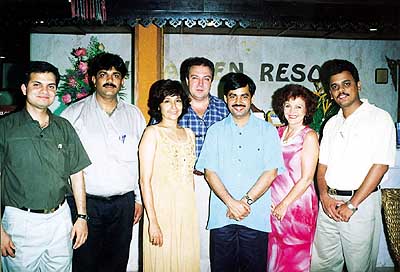
On
their visit to Pattaya, the delegates stopped by the Thai Garden Resort
for a buffet dinner and chat with Ashley Moneiro (far left), MD of
Pathfinders Travel Co., Ltd., who organizes tours in Thailand for Indian
tourists, Anil Rai (2nd left), manager - destination management services,
Cox & Kings, India’s oldest and biggest travel agency, Pattaya
Mail’s Sue Malhotra (3rd left), Thai Garden Resort GM Rene Pisters (back
center), Union Minister of Civil Aviation Syed Shahnawaz Hussain (center
right), guest relations manager of the Thai Garden Resort Elfi Seitz (2nd
from right), and Rajeev Kale (far right), general manager of contracting
for Leisure, Cox & Kings.
The Air India route has opened a new gateway for Assam
and other North Eastern states of India - Arunachal Pradesh, Manipur,
Meghalaya, Mizoram, Nagaland, Sikkim and Tripura, providing increased
activity throughout the region, by promoting tourism in more or less
unexplored tourist destinations in the Indian North Eastern region.
The North East also boasts of several places of
historical interest, including magnificent palaces. The religious minded
can visit the splendid temples, Buddhist monasteries or churches and it is
that which Syed Shahnawaz Hussain wished to emphasize on his visit to
Thailand. Hussain said, “This is the biggest news. The northeastern area
is where Buddhism began and we want to promote this through Buddhist
countries. It is similar to Mecca and Medina for the Muslim population of
the world. We plan to have an ‘Open Sky’ policy where everyone can
visit the region.”
The Indian government has spent over 1,120 million
rupees (1.05 billion baht) in upgrading the airport and the surrounding
infrastructure to support the project.
“We also want to promote eco-tourism in the northeast
and within the next few months, we (the Indian government and civil
aviation) will open another international airport in Gaiya,” Hussain
said.
The Northeast of India is a veritable melting pot of
culture and modern flavors, with exotic wildlife, exquisite textiles,
tribal shawls which are available in a variety of colors and designs, cane
and bamboo artifacts, and other unusual souvenirs, as well lush green tea
gardens and numerous golf courses to play on, many of which have air
strips nearby. The capital, Assam is considered an important commercial
hub of the region, representing the spirit of modern India, the gateway to
the north east, with Gauhati straddling the banks of the Brahmaputra
River.
During his brief visit to Pattaya, Hussain and the
delegates visited a number of tourist destinations such as Alcazar and Koh
Larn. He said that he was very impressed with Thailand and its people.
Syed Shahnawaz Hussain is India’s youngest ever
cabinet minister and at 32, he has already held five senior government
positions, making him one of the more experienced members of Indian
Parliament. He is being described by many as one of the most dynamic and
politically aggressive leaders on the sub-continent. He also sits on the
board of Air India.
Air-India will be undertaking an aggressive marketing
campaign to promote services to suit travelers with varied budgets from
Gauhati to the Far East. Air-India will organize familiarization tours for
journalists from the Far East to this picturesque region, which has so
much to offer to the discerning traveler.
Sheraton Grande Sunday Menu: Buffet Lunch and Jazz A La Carte
Story and photos by Peter Cummins
Everyone has a birthday and, for the fortunate, it is a
day of celebrations, fun - and, even - a dinner with wine, as we become
adults. The Sheraton Grande Sukhumvit recently had a birthday - and it was
a splendid affair. It was actually the first anniversary of the
Sheraton’s now-famous “Jazzy Brunch”. This most popular Sunday
buffet lunch, which extends well into the afternoon, features an
absolutely sumptuous spread of food from the ‘four corners of the
world”, liberally placed around amongst salads, oysters, deserts; in
fact, it would be hard to imagine anything missing from the huge lay-out.
But why “Jazzy”? I thought it meant the term often used to indicate
something modern, up-market - even hip, if you wish - such as, “That’s
a ‘jazzy’ tie you are wearing!”
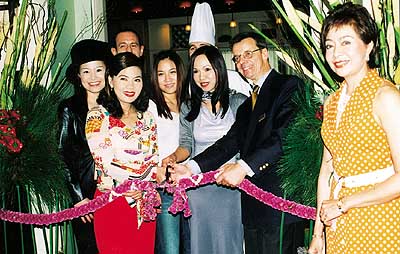
Richard
Chapman and Sheraton Grande staff celebrate the first birthday. At left is
radio/television star, Jennifer Su.
Although certainly in a linguistic sense it does mean
up-market, hip etc., in this case it means REAL JAZZ (which, of course,
also relates to those other meanings) and there, to honour the
Sheraton’s first birthday celebrations and entertain the capacity crowd,
were two award-winning jazz musicians, the “Two for Brazil” duo,
Paulinho Garcia and Greg Fishman, recently awarded the coveted title of
the “Best Jazz Entertainer(s) of 2001” at the Twenty-first Annual
Chicago Music Awards”. In fact, it seemed that half of Bangkok was also
having birthdays that day: more than six times during the show the “Two
for Brazil” veered away from the Latin flavour to break into a rousing
“Happy Birthday” for someone at one of the tables. Even this Pattaya
Mail special correspondent entered the “Birthday Stakes”.
Sheraton general manager Richard Chapman, with Denis
Thouvard, director of Sheraton Food and Beverage and a bevy of beautiful
staff members standing by cut the ceremonial ribbon across the entrance of
Rossini’s, to usher in the second year of Bangkok’s favourite social
rendezvous - especially on Sundays. Anyone who is anyone around the
metropolis was there, including well-known television and radio
personality Jennifer Su, sporting her trademark hat for the occasion.
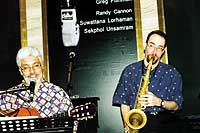 The
“Two for Brazil”, Paulinho Garcia (L) and Greg Fishman go Latin, with
a few ‘happy birthdays’ in between. The
“Two for Brazil”, Paulinho Garcia (L) and Greg Fishman go Latin, with
a few ‘happy birthdays’ in between.
The Sheraton, which excelled in the numerous categories
of excellence cited in current listings of the annual Metro Awards for
Food and Nightlife, literally ‘ran away’ with the Metro award for the
“Best Brunch Buffet”.
At under 1,000 baht per adult (half for children), with
the superior service which is the hallmark of this great hotel, a smiling
and friendly staff and, undoubtedly, the best food in a city renowned for
great food, next time you stay in Bangkok on Sunday, you owe it to
yourself to spend a few hours at the “Jazzy Brunch”. Of course the
“Two for Brazil” will not be playing but, for sure, there will be an
equally talented group there, while you enjoy the superb ambience for a
few delightful hours.
The only problem is that when you return outside to the
streets of Bangkok, you will have forgotten that you were actually in
Bangkok and not in Paris or Rio.
Bon Appetit!
|
|
|
|
News | Business News | Features | Columns | Letters | Sports | Auto Mania
Kid's Corner | Who’s Who | Travel | Our Community | Dining Out & Entertainment
Social Scene | Classifieds | Community Happenings | Books Music Movies
Club in Pattaya | Sports Round-Up
E-mail: [email protected]
Pattaya Mail Publishing Co., Ltd.
370/7-8 Pattaya Second Road, Pattaya City, Chonburi 20260, Thailand
Tel.66-38 411 240-1, 413 240-1, Fax:66-38 427 596
Copyright © 2002 Pattaya Mail. All rights reserved.
This material may not be published, broadcast, rewritten, or redistributed.
|
|
|



 Mayor
Pairat Suthithamrongsawat arrived at the festivities by horse drawn
carriage.
Mayor
Pairat Suthithamrongsawat arrived at the festivities by horse drawn
carriage. Pattaya’s
Songkran Festival featured stage performances, games and plays.
Pattaya’s
Songkran Festival featured stage performances, games and plays. Devout
Buddhist poured water over statues of Buddha.
Devout
Buddhist poured water over statues of Buddha. After
the parade, Mayor Pairat and friends paid respect to their elders in the
traditional way.
After
the parade, Mayor Pairat and friends paid respect to their elders in the
traditional way. Indigenous
Thai instruments were featured during the parade.
Indigenous
Thai instruments were featured during the parade. There
was still the small army of beer-filled farangs and service girls who
chose to ignore traditional Thai values and soak everyone in sight.
However, this year by doing so they just might contribute to the filling
of police coffers, as there has been a 2000 baht fine announced for using
PVC pipes (like the ones shown here), ice water and talcum powder.
There
was still the small army of beer-filled farangs and service girls who
chose to ignore traditional Thai values and soak everyone in sight.
However, this year by doing so they just might contribute to the filling
of police coffers, as there has been a 2000 baht fine announced for using
PVC pipes (like the ones shown here), ice water and talcum powder.


 The
“Two for Brazil”, Paulinho Garcia (L) and Greg Fishman go Latin, with
a few ‘happy birthdays’ in between.
The
“Two for Brazil”, Paulinho Garcia (L) and Greg Fishman go Latin, with
a few ‘happy birthdays’ in between.

